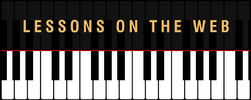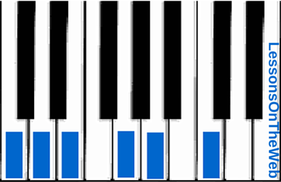|
Ever heard of a 5 note scale? While you might not have heard "of" it, I bet you've heard it before in music, and didn't realize it! A 5-note scale is called a Pentatonic Scale. In the above diagram, there are actually 6 notes highlighted... showing a C major Pentatonic Scale; but notice that the last note is the 1st note repeated, just an octave higher. The notes are - C, D, E, G, A, and then the C again. Notice that the notes that are left out, are F, and B. In most of the regular scales that we first learn on the piano, there are 8 notes; 7 unique notes with the 1st one repeated on the 8th tone, just as in the Pentatonic Scale. If we were playing the above C Major Scale as we first learned it, we would play - C, D, E, F, G, A, B, and then the C again. Pentatonic Scales are used in lots of different types of music. You'll find it in:
In early Folk music, Pentatonic Scales established a melody that was then easily improvised upon by the musicians. Later, as it began being used in Jazz and especially Rock music. Many rock n roll solos are improved versions of the Major Pentatonic Scale, just in it's minor form. What's even more interesting about a Pentatonic Scale, is that you can interchange keys within a scale. For example, if you're playing in the key of C, you can also incorporate other Pentatonic scales, such as A minor, or G minor within the same chords, which gives those of you that improvise, more options than if you were playing with 8 note scales. Pentatonics are great for learning to improvise! More teachers use Pentatonic Scales to get students going on improvisation than not. That's why they are so popular with Jazz and Rock artists, who are known for their live improv performances and jam sessions. And...because you can overlap keys when playing in this format, improving is easier because there are more options. How Can You Start Playing with Pentatonic Scales? Take-5, and pick-5. Meaning, take 5 minutes...sit down...find middle C...now play C, D, E, G, A and then your C again. That's it! How do you do that in another key? Move up to D. Now play D, E, F#, A, B, and then the D again. For major Pentatonic Scales, play the 1st, 2nd, 3rd, 5th, 6th tones of the scale. There are also a ton of minor Pentatonic Scales, but for now, learning the basics and experimenting with them in the Major Keys is a great start, and won't be overwhelming. Here is a great chart showing all of the Major Key Pentatonic scale notes on the keyboard. So start experimenting this week with some easy Pentatonic Scales! Once you have figured how to do it in one key, move around through all of the major scales and pick out the 5 notes that make up the Pentatonic Scale, and there you go! The best part is for those that love to improvise, this will open up all kinds of new doors of possibilities for you to explore and play in...and with! To help you get acquainted with the Pentatonic Scale, take a look at Bobby McFerrin teaching one to an audience...you'll have some fun with this one!
9/19/2020 04:30:35 pm
I enjoyed this brief illustration on Pentatonic scales. I'm new at piano. Desiring to learn more.
Reply
michael Robinson
12/28/2020 07:59:02 pm
Thank you, this was so enlightening
Reply
Pat Foss
1/22/2022 06:51:38 pm
Pentatonic scales are new to me, you made that look like so much fun.😀
Reply
Anonymous
12/23/2022 10:26:17 am
Cool man!
Reply
Leave a Reply. |
AuthorMost blogs written by Archives
June 2020
Categories
All
|



 RSS Feed
RSS Feed